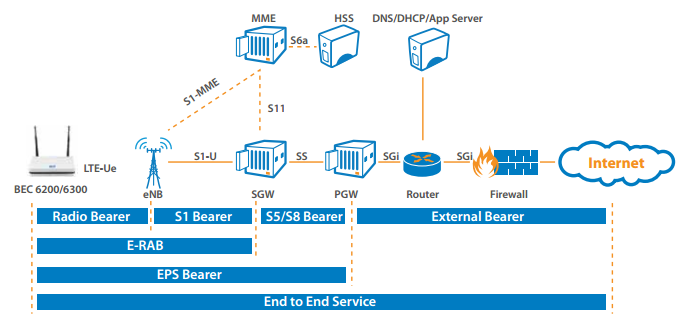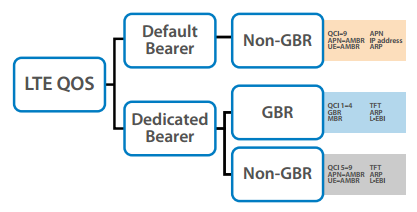LTE Quality of Service (QoS)
QoS has become an important part of network planning & design. Every user has their own requirements. There are subscribers who use LTE services for critical operations (e.g. voice calls, bank transactions, hospital operations) and there are subscribers who just want to enjoy premium Internet. LTE was designed to meet these increased data and application demands with reliable connections and low cost of deployment. A best case scenario would feature a highly-flexible QoS framework that is built to withstand future challenges. Advanced LTE QOS defines priorities for certain customers or services during congestion.
In LTE Broadband Network QoS is implemented between CPE and PDN Gateway and is applied to a set of bearers. 'Bearer' is basically a virtual concept and is a set of network configuration to provide special treatment to set of traffic e.g. VoIP packets are prioritized by network compared to web browser trac. In LTE, QoS is applied on Radio bearer, S1 bearer and S5/S8 bearer, collectively called as EPS bearer as shown in figure below:

Understanding Default & Dedicated Bearer:
To best implement the concept of Qos in a LTE network, we must understand the bearer types and properties associated with each bearer. Two types of Bearer exist - Dedicated bearer and Default bearer. Default bearer is established when a CPE is initially attached to LTE network while dedicated bearer is always established when there is need to provide QoS to specific service (like VoIP, video etc).

Bearer in fixed broadband LTE network is similar to virtual traffic management concept. Bearers pre-determine how the user end data is treated when it travels across the LTE network. Network might treat certain type of data in a prioritized or different way and treat other data normally. Some flow of data type might be provided guaranteed bit rate while other may assign lower transfer rate. In a simply explanation, LTE bearers are sets of network parameter that defines data specific treatment.
One example of using bearers to provide tiered service packages – A premium subscriber will always get at least 5Mbps download speed on his LTE broadband service while for a basic package subscriber there is no guaranteed bit rate and his speed may be subjected to network traffic conditions.
Default Bearer in LTE:
When a LTE broadband CRP initiates connection to the network for the first time, it will be assigned default bearer depend on the service subscribed and remain connected until service is changed or terminated. For many carriers default bearer is best effort service which means speed and quantity may vary depend on network usage and time of the day. Each default bearer comes with an IP address. Each LTE broadband subscriber can have additional default bearers as well. Each default bearer will have a separate IP address. QCI 5 to 9 (Non- GBR) can be assigned to default bearer.

Dedicated Bearer in LTE:
In a simple term, dedicated bearers provide dedicated tunnel to one or more specific traffic (i.e. VoIP, video etc.). Dedicated bearers are the secondary bearers that are created on top of the existing default bearer. Dedicated bearer shares the IP address previously established by the default bearer therefore dedicated bearer does not require to occupy additional IP address.
Dedicated bearer are mostly used as GBR (Guaranteed Bit Rate) services although it can also can be a non-GBR service. On the other hand, Default bearer can only be non-GBR. Carries or service provides that offer voice over LTE would find dedicated bearer useful to maintain high voice quality and improve user experiences. Carrier or SP can use a TFT within dedicated bearer to assign special rule of treatment to specific data or services. SIP or VoIP services can be .
For services like VoLTE we need to provide better user experience and this is where Dedicated bearer would come handy. Dedicated bearer uses TFT to give special treatment to specific services.

Dedicated bearer can be subdivided into Non-GBR and GBR types.
GBR - The minimum guaranteed bit rate per EPS bearer. GBRs are specified individually for uplink and downlink.
A value of a GBR QoS parameter is pre-determined and associated to the bearer. If the traffic carried by that GBR bearer conforms to the value of associated with the bearer, congestion-related packet losses will not occur on the services utilizing that GBR bearer. This can be initiated on the network end (e.g. the access base stations) during activation or admission control processes, and are executed when the bearer is established.
A GBR bearer typically is established “on demand” because it blocks transmission resources by reserving them in an admission control function.
An LTE fixed broadband carrier may leverage GBR bearers to implement “service blocking” rather than “downgrade service”. For most carriers this is a preferred user experience, in which network carriers block a service request rather than enabling all services with degrades quality and performance.
This is relevant in scenarios in situations voice services will remained up while data and other traffics will be discontinued during an emergency or extreme heavy network loading.
Non-GBR – No minimum guaranteed bit rate per EPS bearer.
On the other hand Internet network service utilizing a non-GBR bearer is prone to congestion related packet losses. Non-GBR does not block any network specific traffic or transmission resources. A non-GBR is established in the default or dedicated bearer and however, can remain established for a long period of time.
Whether a service is realized based on GBR or non-GBR bearers, the policy of a carrier or service provider is depend on anticipated trac load versus dimensioned capacity. Assuming sufficiently dimension capacity is available, any service, both real time and non-real time, can be realized based on non-GBR bearer.
Other parameter associated with all bearers - QoS class of identifier (QCI) which defines IP level packets characteristics:

The expansion and migration burden on carriers’ cellular infrastructure continues to grow rapidly. While advanced modulation techniques and antenna technologies have made great improvement in increasing RF & network efficiency, limitation on usable radio spectrum and back-haul capacity is a everyday challenge and expensive.
If voice & video traffic were treated as normal packet data, an LTE network would deliver it (alongside every other type of traffic) via physical shared channels using the default evolved packet system (EPS) bearer originally designed to deliver regular data trac to an application server such as a Web server. These “best effort” IP delivery methods provide no control over service quality.
BEC’s 4G/LTE CPE products introduce the concept of an EPS dedicated bearer to establish specific tolerances for packet delay, error loss, and guaranteed versus non-guaranteed bit rates. Dedicated bearer setup along with BEC’s Dual APN service enable quality controlled services with highest user experiences and satisfaction.
